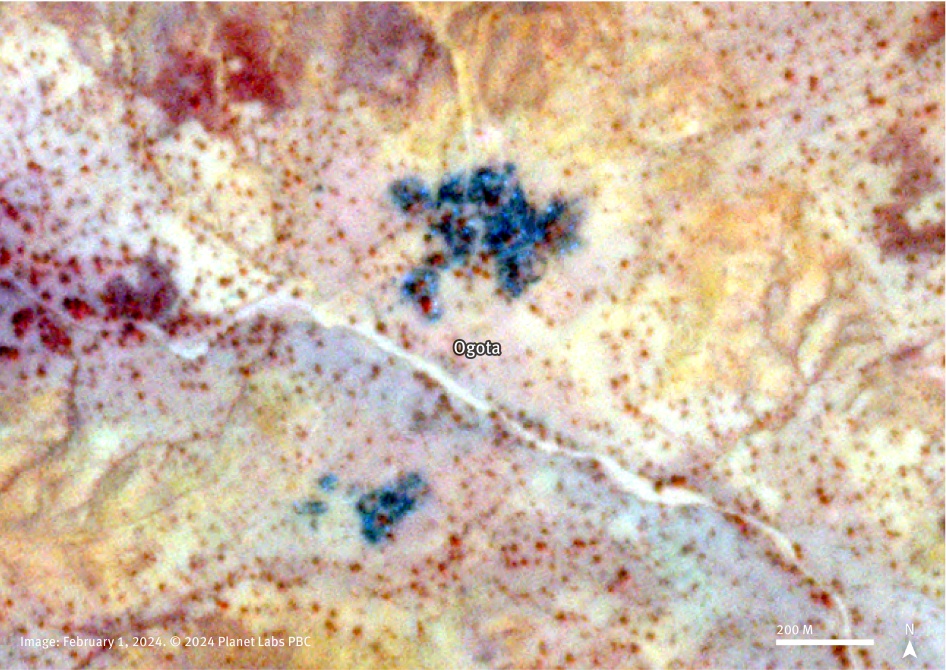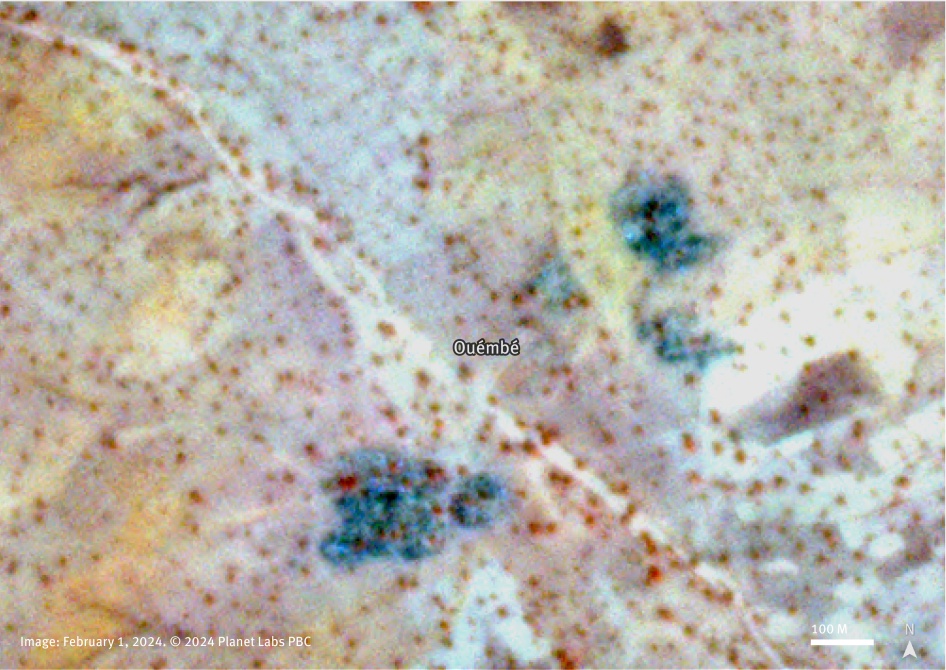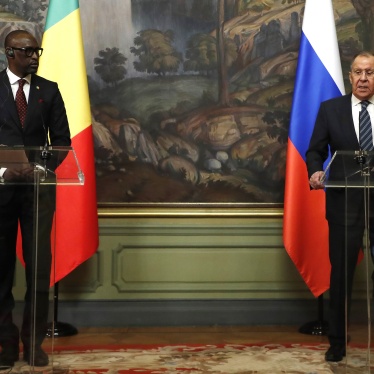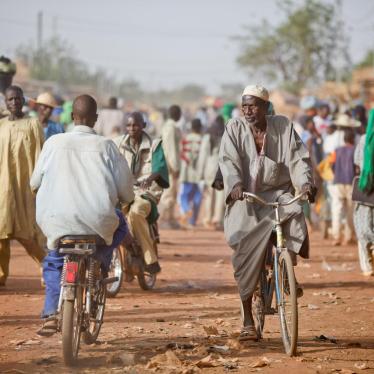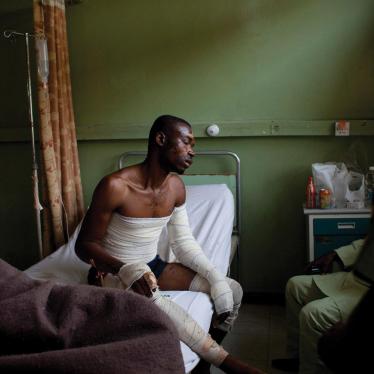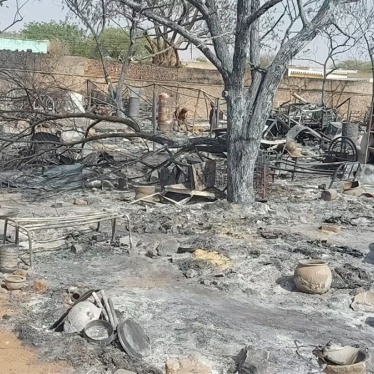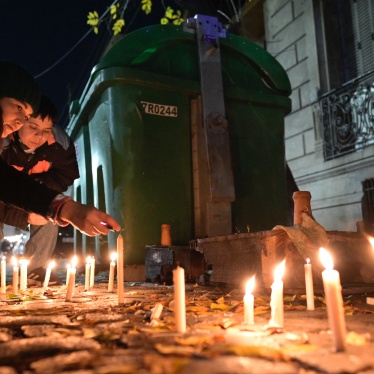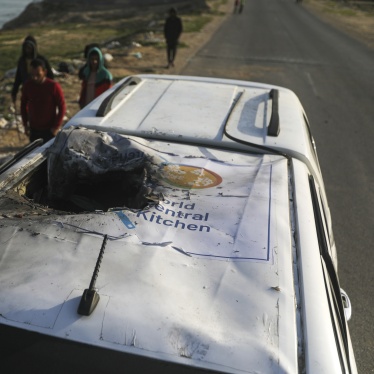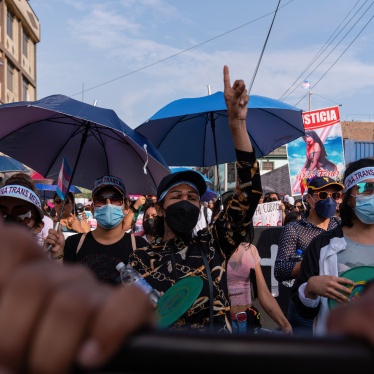(Nairobi) – An Al-Qaeda-linked Islamist armed group killed at least 32 civilians, including 3 children, and set fire to over 350 homes in central Mali in January 2024, forcing about 2,000 villagers to flee, Human Rights Watch said today. Earlier in January, an ethnic militia killed at least 13 civilians, including 2 children, abducted 24 other civilians, and looted property and livestock in central Mali. These attacks violate international humanitarian law and are apparent war crimes.
Human Rights Watch documented two attacks by the Group for the Support of Islam and Muslims (Jama’at Nusrat al-Islam wa al-Muslimeen, JNIM) on the villages of Ogota and Ouémbé, Mopti region, on January 27, and two attacks by Dozo militia on the villages of Kalala and Boura, Segou region, in early January. These attacks occurred amid recurrent tit-for-tat killings and communal violence in central Mali. Mali’s transitional military authorities, which took power in a May 2021 coup, should urgently investigate the abuses, fairly prosecute those responsible, and provide better protection for all civilians at risk.
“Islamist armed groups and ethnic militias are brutally attacking civilians without fear of prosecution,” said Ilaria Allegrozzi, senior Sahel researcher at Human Rights Watch. “The authorities need to act to end the deadly cycles of violence and revenge killings and better protect threatened civilians.”
Between February and April, Human Rights Watch interviewed 25 people by telephone with knowledge of the attacks, including 15 witnesses, 3 Malian activists, and 7 international organization representatives. Human Rights Watch also analyzed satellite imagery of burned homes in Ogota and Ouémbé.
Mali has been fighting Islamist armed groups linked to Al-Qaeda and the extremist armed group Islamic State (also known as ISIS) since 2015. In December 2023, the United Nations Multidimensional Integrated Stabilization Mission in Mali (MINUSMA), pulled out of the country at the request of Mali’s transitional military authorities, raising concerns about protecting civilians and monitoring abuses. In January, the transitional authorities announced that Mali would leave the Economic Community of West African States (ECOWAS), depriving abuse victims of the ability to seek justice through the ECOWAS Community Court of Justice.
Witnesses said that on January 27 the JNIM attacked Ogota, populated mainly by ethnic Dogon, as retaliation for the presence of Dan Na Ambassagou militia in the vicinity. “They invaded the village, shooting at anything and anyone for more than an hour,” said a 40-year-old woman. “They set the whole village on fire.”
On January 6, Dozo militia attacked Kalala, a predominantly ethnic-Fulani village, and killed 13 civilians. “We found six bodies in front of the mosque, and the others inside homes or outside,” said a herder. “The Dozo targeted us because we are Fulani, and they think all Fulani are terrorists.” Witnesses from Kalala said the attack was retaliation for JNIM’s attacks against ethnic Bambara in surrounding villages in October and November.
Malian transitional military authorities have not adequately investigated incidents implicating members of Islamist armed groups or ethnic militias, Human Rights Watch said. In his February report, Alioune Tine, the UN Independent Expert on the situation of human rights in Mali, stated that he regrets “that no significant progress has been made in prosecuting the alleged perpetrators of multiple violations and abuses of human rights and violations of international humanitarian law attributed to violent extremist groups, militias and community self-defence groups and Malian forces.”
Witnesses to the JNIM attacks said that the Malian security forces failed to adequately protect their communities. “The Malian state has abandoned us,” said a 34-year-old man from Bankass, Mopti region. “Since 2018, the jihadists have imposed Sharia [Islamic law] on us, attacked our villages, mined our roads, [and] kidnapped our children. We have always called for help from our authorities, but there has been no response. These attacks continue because terrorists enjoy freedom of action and are never held accountable.” A witness to the Dozo militia attack in Boura on January 3, however, found the authorities willing to respond promptly, saying that local gendarmes “acted quickly … and arrested three militiamen.”
Human Rights Watch has also documented serious abuses by the Malian security forces and apparent Russia-backed Wagner forces during counterinsurgency operations in central Mali.
Under international humanitarian law, the fighting in Mali is considered a non-international armed conflict. Applicable law includes Common Article 3 to the Geneva Conventions of 1949 and customary laws of war, which apply to non-state armed groups as well as national armed forces. The laws of war prohibit summary executions, torture, attacks on civilians and civilian property, and looting, among other violations. The government has an obligation to impartially investigate and appropriately prosecute those implicated in war crimes, which are serious violations of the laws of war committed with criminal intent.
“The Malian transitional government’s failure to hold Islamist armed groups and ethnic militias to account only emboldens abusive forces to commit further atrocities,” Allegrozzi said. “The authorities should ramp-up efforts to appropriately investigate and prosecute all those responsible for grave abuses.”
For witness accounts and other details, please see below. The names of those interviewed have been withheld for their protection.
Abuses by the JNIM
The Islamist armed group JNIM emerged in March 2017 as an umbrella coalition of Al-Qaeda-aligned groups, including Ansar al-Din, Al-Qaeda in the Islamic Maghreb, al-Mourabitoun, and Katibat Macina. Human Rights Watch has previously documented serious abuses by the JNIM across Mali.
The JNIM has concentrated its recruitment efforts on ethnic Fulani, exploiting their frustrations over government corruption and competition over natural resources. This has exacerbated tensions between the Fulani and other ethnic groups, especially the Bambara and Dogon, leading to the formation of ethnic self-defense groups, such as the Dozo and Dan Na Ambassagou, which have taken protecting their villages and property into their own hands.
Ogota and Ouémbé, Mopti Region, January 27
On January 27 at about 6 p.m., scores of JNIM fighters armed with Kalashnikov-style assault rifles and riding motorbikes and vehicles mounted with heavy machine guns led simultaneous attacks on Ogota and Ouémbé villages, three kilometers apart, four witnesses said.
The fighters, who wore headscarves and spoke Fulfulde, a language widely spoken in Mali, killed 28 villagers in Ogota, including 8 women, 4 older men, and 3 children, and 4 villagers in Ouémbé, including 2 women. Witnesses said the fighters burned at least 150 homes in Ogota and 130 homes in Ouémbé, then returned on February 1 to burn the remaining intact homes.
On January 29, international media reported the attacks, citing information from local authorities. In a February 1 statement, the UN High Commissioner for Human Rights, Volker Türk, said he was “alarmed by reports that about 30 civilians were killed in attacks by yet unidentified gunmen” on Ogota and Ouémbé, and called for an impartial investigation and for those found responsible to be “brought to justice in trials observing international standards.”
A 46-year-old farmer from Ouémbé said:
I saw the terrorists coming. They split into two groups: one headed toward Ouémbé, and the other toward Ogota. The group heading toward Ouémbé … was made up of about 20 motorcycles and a pickup truck with a machine gun mounted on top. The group heading to Ogota was larger. A few minutes after the convoy passed me, gunshots were heard from Ogota, then gunshots could also be heard from Ouémbé. The shooting lasted about an hour and a half.
Villagers said they believed they were attacked because some members of the Dan Na Ambassagou militia refused to lay down their weapons following a deal between the militia and the JNIM. The Dan Na Ambassagou is an umbrella organization of self-defense groups started in 2016 “to protect the Dogon country” that provided security in Ogota, Ouémbé and surrounding villages.
A 24-year-old former Dan Na Ambassagou militiaman from Ogota said:
At the beginning of the movement, we fought the jihadists, but in late 2018, we realized that the jihadists were better armed and that our involvement in the militia made our villages the targets of the jihadists. The jihadists cut off market roads, kidnapped our relatives, prevented us from practicing agriculture, and besieged our villages to the point that our children died of hunger. Some of us decided to negotiate with the jihadists and lay down weapons. However, some militiamen refused the negotiations, so our movement split into two: we accepted a deal with the jihadists, others continued to fight them. It’s because of those who kept fighting that our village was attacked.
Witnesses from Ogota and Ouémbé said that residents learned days earlier about an imminent threat from the JNIM. They contacted Malian soldiers based in Bankass and in Bandiagara, respectively about 40 and 70 kilometers from Ogota and Ouémbé, seeking protection, without success.
A 46-year-old farmer from Ouémbé said:
We have been living with the terrorists since 2018. When they have bad intentions against a village, they say it clearly in the WhatsApp groups. So, we contacted our relatives who are civil servants in Bandiagara asking them to inform the soldiers about the threats against our village and Ogota. They met with the military authorities in Bandiagara and told them that the terrorists were gathering in the bush at Bankass and that they planned to attack our villages. But the soldiers didn’t do anything.
Killings in Ogota
Villagers from Ogota said JNIM fighters came at sunset from the southern side of the village. They started shooting heavily from the top of a hill causing villagers to panic and flee. They then stormed the village, firing at people trying to escape or hide.
A 40-year-old woman said:
The jihadists spoke in Fulfulde language and shouted “Allah Akbar” [God is great]. They cheered saying the “enemy village has fallen,” and “this is what we are going to do with all the villages that do not respect Islam.” My husband fled as the shooting started, leaving me and my children in the house. Two women with their children came and hid with us. When the shooting stopped, we decided to leave, but as soon as we went out, gunfire resumed, I was hit in my legs and fell. The two women left me behind and ran with my children.… When the jihadists left, my husband came back to rescue me.
The former militiaman said that when the attack started, he phoned members of the Dan Na Ambassagou militia for help, “but they only came when the jihadists had already left.”
A 34-year-old man said:
When the attack started, I was about four kilometers from Ogota. I heard bursts of machine-gun fire for an hour and a half, and I saw flames coming out from the village. When the shooting stopped, I went back to Ogota and found some villagers and militiamen who were trying to rescue the injured.… The village was covered in smoke, and we could see dead bodies inside and outside homes. Some people had been shot while running, others were executed in their homes. Homes were still on fire. In one house, we found five bodies charred: one woman, a 50-year-old man, and three older men.
Human Rights Watch reviewed two lists of victims compiled by survivors and residents, with the names of 28 people killed, including 3 children under age 2, 4 men over age 68, and 8 women between 30 and 50. At least 5 of those killed appeared to have been shot in the head, 9 were burned, and the remaining were riddled by bullets, witnesses said.
“We buried the bodies the day after the attack,” said a 45-year-old farmer. “Some bodies had bullet wounds everywhere. Others, especially those charred, could not be lifted, so we buried them where we found them. The others were buried separately.”
Killings in Ouémbé
Villagers from Ouémbé described a similar scenario.
“I was home when I heard heavy gunfire,” said a 43-year-old farmer. “By the time I had gathered my family, I saw the terrorists coming in large numbers. They screamed ‘Allah Akbar’ and shot continuously. I fled to Segué.”
A 46-year-old man said:
We heard repeated gunshots and bursts of machine-gun ‘pa-pa-pa.’ I fled to the bush before the terrorists invaded the village.… When shooting stopped at night, I came back and found the bodies of four people, two men and two women, in a home where they were probably hiding.… They had been shot in the chest and the head. We buried them the following day.
Human Rights Watch reviewed two lists of victims compiled by survivors and residents, with the names of four people killed, two men, between ages 50 and 60, and two women, between 30 and 40.
Arson in Ogota and Ouémbé
Witnesses said that during the January 27 attacks, JNIM fighters set on fire at least 150 homes in Ogota and about 130 in Ouémbé, forcing about 2,000 villagers to flee. They also said that the fighters came back four days later to burn remaining homes in Ogota and Ouémbé.
“It was a ghost village,” said the 45-year-old man from Ogota who returned to the village after the attack and later fled with his family to Bankass.
“There was nothing left of the village,” said the 46-year-old man from Ouémbé who returned to the village after the attack. “People had fled, the houses were still burning. All the people have been displaced, including myself and my family. We are now in Bankass and lack everything.”
On satellite imagery that Human Rights Watch analyzed, burn marks are visible all over Ogota and Ouémbé villages. They first appeared over both villages on an imagery from January 28, 10:38 a.m. local time, and were not visible the previous day at the same time. Additional burn marks appeared over both villages on an imagery of February 1, 10:38 a.m. local time, that were not visible the day before.
Abuses by Dozo Militia
The Dozo, or “traditional hunting societies,” consisting mainly of ethnic Bambara, have acted as village self-defense forces in Segou and Mopti regions since about 2014. Human Rights Watch has previously documented serious Dozo abuses against Fulani civilians, as well as allegations that Dozo and other self-defense groups have acted as Malian army proxies.
Kalala, Segou Region, January 6
On the evening of January 6, Dozo militia attacked Kalala and killed 13 people, including 3 older men, one of them blind, an older woman, and 2 children, 3 witnesses said. They also burned at least one home, 10 huts, and 20 sheds.
Villagers believe that the Dozo attacked Kalala, with a predominantly Fulani population, in retaliation for JNIM attacks against ethnic-Bambara in several surrounding villages in late 2023.
A man from Kalala said:
Between October and November 2023, some people from Berta, Diado, Kéré, Goumba and Kafagou, which are mainly populated by ethnic Bambara, began arming themselves, breaking the deals they had made with the jihadists. The jihadists then chased them out of their villages. Those driven out of their homes organized themselves and attacked Kalala, a village mostly inhabited by ethnic Fulani. A Fulani village in our area is considered a jihadist village by other communities.
Witnesses said that scores of Dozo militiamen riding motorbikes, wearing distinctive brown hunting clothes and amulets around their necks, and carrying Kalashnikov-style assault rifles and hunting guns, arrived in Kalala after sunset. They stopped at the village football field and started shooting. They headed to the mosque and summarily executed at least six men.
A villager said:
When I saw a dozen Dozo heading towards the mosque, I hid in the mosque’s toilet.… The Dozo rounded up six men in front of the mosque and one Dozo shot each person in the head. I watched the scene from the door [of the toilet]. Among the six were the village chief, the muezzin [who makes the call to the daily prayer], an 83-year-old blind man, and an 80-year-old man.
Witnesses said that, after the killings, the Dozo went door-to-door, looting, burning huts and other properties, and killed seven more people.
A 45-year-old woman said:
I bumped into two Dozo militiamen. One asked me: “Where are your children and your husband?” I replied that my children were not around and that my husband is visually impaired, I begged them to have mercy on us.… They left but set fire to the shed in front of the house.… My husband told me to leave him behind and flee.… I joined 20 other women and children. We walked through the bush at night.… At 6 a.m., we split, some went east, toward Tionce; others went west, toward Saye. I went to Kalala Bamara where a woman helped me and took me in her wheelbarrow back to my village to look for my husband.
The woman said that when she arrived in the village, she saw the bodies of 13 people. “Some [were] shot in the head,” she said, and “the village had been looted” with “several huts and sheds burned.” She found her husband alive and fled with him to Saye.
A man who helped bury the bodies in Kalala said:
We could not bury our relatives for many days because we feared more attacks by the Dozo. On February 3, we decided to go back and found that the bodies of the six men killed in front of the mosque had already been buried in a mass grave, which was uncovered. We don’t know who dug it, but we think the jihadists [JNIM] did it. We just covered it with sand, buried the seven other bodies, and left in a hurry.
Human Rights Watch obtained three lists of victims compiled by survivors and Kalala residents, with 13 names of people between ages 4 and 83. Among those killed, witnesses said, was the village chief and an older woman whose charred body was found in her house.
Boura, Segou Region, January 3
On January 3 at about 8 a.m., scores of Dozo militiamen, riding at least 100 motorbikes, stormed the village of Boura, abducting 24 people, including the 72-year-old village chief, three witnesses said. They also looted homes and livestock.
Witnesses said that the Dozo came from the locality of Ndokoro, 14 kilometers away, and attacked the predominantly ethnic Fulani village. Since late 2023, JNIM had abducted Dozo militiamen in several villages surrounding Boura.
“At the beginning of 2023, the army patrolled our area, so the jihadists suspected that the Dozo were collaborating with the military,” said a 40-year-old woman. “The jihadists then started to kidnap some Dozo. And in retaliation, the Dozo attacked our village.”
Human Rights Watch has previously reported allegations that Dozo and other self-defense groups acted as Malian army proxies.
Witnesses said that the militiamen came with motorbikes, wore distinctive brown hunting clothes and amulets, and carried Kalashnikov-style assault rifles. They said the assailants went door-to-door looking for men and looting homes.
The 40-year-old woman said:
My husband was able to escape. I tried to escape too with my children, but the village was already cordoned off. I went back home and prayed to God. Two Dozo came to my house, asked me where my husband was. I said he wasn’t there. They broke into the house and forced me to give them my silver jewelry.… At about 10 a.m., they left the village.… Everything had been looted. All the men had fled. Only the women and children remained.
Human Rights Watch reviewed a list compiled by survivors and Boura residents with the names of the people abducted, including 23 men, ages 18 to 80, and a 17-year-old boy.
A 50-year-old man, who fled at the Dozo’s arrival, said he went to Segou city, 140 kilometers away:
I went to the gendarmerie to inform the gendarmes that our village had been attacked by a hundred of the Dozo who looted the village, took our animals, and kidnapped people. The gendarmes registered my complaint.… The gendarmes acted very quickly and went to seal off the road connecting Segou to our village.… The following day, the gendarmes were able to stop a truck carrying our looted animals, more than 60 cows, and arrested three Dozo.
Witnesses said that family members of those abducted did not look for their loved ones out of fear of attacks by the Dozo. “Some people told us that they had been killed, but none found their bodies and there is no evidence of that,” said the 40-year-old woman. The 50-year-old man who reported the attack to the gendarmerie said he also informed gendarmes about the abductions, but “we still have no news.”


